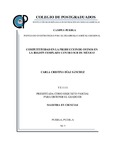Competitividad en la producción de ovinos en la región templada centro-sur de México.
Abstract
La demanda de carne de ovino en México representa una oportunidad para mejorar los medios de vida de los pequeños productores. Sin embargo, son escasos los trabajos realizados en el sistema de producción campesino, por lo que el objetivo de la investigación fue analizar la contribución de la producción de ovinos al bienestar de la familia y evaluar la rentabilidad y competitividad de los sistemas tradicionales de producción de ovino en la región templada centro-sur de México. Una muestra de 139 productores de ovinos, seleccionados en forma aleatoria, se entrevistó en 10 municipios de los estados de Puebla y Tlaxcala, para registrar información de la familia, rebaño, tierra, venta de ovinos y la línea de bienestar mínimo. La evaluación de la rentabilidad y competitividad se realizó en tres sistemas de producción en la región de Libres, Puebla, siguiendo la metodología de la Matriz de Análisis de Políticas. Para determinar la productividad de los sistemas de producción se evaluó la ganancia de peso de 258 corderos del nacimiento hasta los 210 días de edad. En la región, 28.8% de los hogares cubren las necesidades básicas alimentarias y no alimentarias con el ingreso por venta de corderos, al colocarse por encima de la línea de bienestar; 29.5% solo puede cubrir el valor de la canasta alimentaria, y 41.7% de los hogares están por debajo de la línea de bienestar mínimo. El sistema con alimentación en corral fue el más rentable y competitivo de acuerdo a la Relación del Costo Privado. Las divergencias y los coeficientes de protección indican que la competitividad de los sistemas fue afectada por la escasa participación institucional, la ausencia de políticas que promuevan la productividad y la eficiencia del sector, y la presencia de oligopsonio en el mercado de ovino. El criterio de los productores para el momento de venta fue el mayor peso vivo adulto; aunque la venta inició entre los 30 y 90 días de edad. La competitividad de la producción de ovinos se puede mejorar orientando la producción a la venta de cordero destetado; opción que aumentaría las ganancias de los pequeños productores y el bienestar del hogar, donde las políticas públicas juegan un papel importante para mejorar la rentabilidad y competitividad de estos sistemas. _______________ COMPETITIVENESS IN THE PRODUCTION OF SHEEP IN THE SOUTH CENTRAL TEMPERATE OF MEXICO. ABSTRACT: The demand for sheep meat in Mexico represents an opportunity to improve the livelihood of small producers. However, there is limited research on peasant production systems; so the aim of this study was to analyze the economic and productive contributions of sheep to family well-being and to evaluate the profitability and competitiveness of the traditional production systems in the south-central temperate region of Mexico. A sample of 139 sheep producers, randomly selected, was interviewed in 10 municipalities in the states of Puebla and Tlaxcala, in order to record information on the family, herd, land, sales of sheep and minimum well-being line. The evaluation of profitability and competitiveness was carried out in three production systems in the region of Libres, Puebla, using the methodology of the Policy Analysis Matrix. The sheep production under these systems were recorded with data of 258 lambs during 210 days. The results show that in the south-central region, 28.7% of the households cover basic food and non-food needs with the income from this activity, when they were rated above the well-being line; 29.5% can only cover the value of the food basket; and while 41.7% of households are below the minimum well-being line. The system of production on feeding indoors was the most profitable and competitive according to the Ratio of Private Cost. Divergences and protection coefficients indicate that the competitiveness of the systems was affected by limited institutional participation, absence of policies that promote productivity and efficiency of the sector, and the presence of oligopsony in the sheep market. The criterion of the producers at sale was the greater adult live weight; although the sale began between 30 and 90 days of age. The competitiveness of sheep production can be improved by orienting the sheep production to the sale of weaned lamb; it could be an option that would increase the profits of small producers and the well-being of the household, where public policies play an important role in improving the profitability and competitiveness of these systems.
Collections
- Tesis MC, MT, MP y DC [398]


